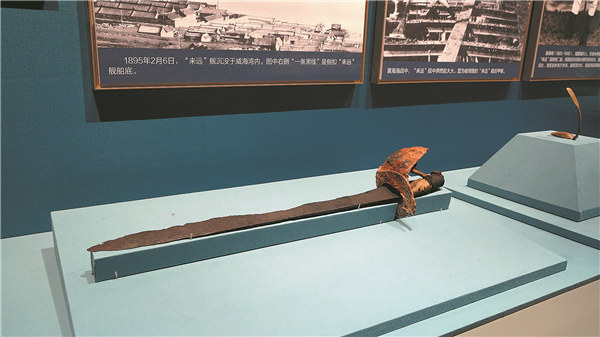Sea reveals fate of heroes
By Zhao Ruixue and Wang Kaihao | China Daily | Updated: 2024-09-19 06:45

Two wooden identity tags retrieved from the shipwreck also helped with identification. The tags are now on exhibit after being soaked in saltwater for preservation. One of the tags has the Chinese characters for lai yuan, "third-class sailor", and "Yu Shengyuan", the name of the sailor in question.
The 82-meter armored cruiser was commissioned from Germany by the Qing royal court and was finished in 1887. Other articles discovered in the wreckage of the Laiyuan include Chinese chess sets, leather shoes, a fragrance bottle, porcelain bowls and combs. All are on display.
Some findings may help partly set the record straight. The general public has long suspected that one of the main reasons why the Beiyang Fleet lost the war was that the Qing government refused to provide the funds to update their naval facilities for a number of years.
Documents show that the fleet made a request to add new canons to the Laiyuan. Shell fuses found in the shipwreck confirm that the vessel had been reinforced for conflict.
"The building of the Beiyang Fleet was a crucial attempt to modernize," Jiang says, adding that archaeological research can help clarify what had previously been questioned.
The culmination of 10 years of underwater work has not only refined methodologies for investigating shipwrecks, but also leveraged technologies, such as sonar and 3D modeling.
"The use of marine magnetometers has played an important role in locating shipwrecks," Jiang says.
The artifacts also provide significant physical evidence to researchers studying the history of a range of specialization, including the Beiyang Fleet, the Sino-Japanese War, and the history of East Asia, Jiang adds.
Zhou echoes Jiang's view.
"We plan to summarize and release reports on the seven vessels based on 10 years of underwater archaeological achievements to provide material for fields, such as the study of naval vessels and vessel equipment," he says.
A report on the cruiser Zhiyuan, the first Beiyang ship that was rediscovered from another site in Liaoning province, has been completed and is on show at the exhibition.
"Ships can be an emotional topic," Jiang says. "Through the remains, we see how sailors sacrificed their lives for the country. Historical study involves flesh and blood, as well as a human touch, as it goes into plentiful details."
Liu Chuan contributed to this story.
- Key evidence found at leading base against Japanese aggression
- Liu Lian plans to compose music using bronze chimes
- Afghan scholars empowered by China's heritage preservation
- Decades of excavation brings Han Dynasty back to life
- Sands of time reveal secrets: Long-term work by Northwest University’s archaeologists in Central Asia helps trace stories of the ancient Silk Road
























